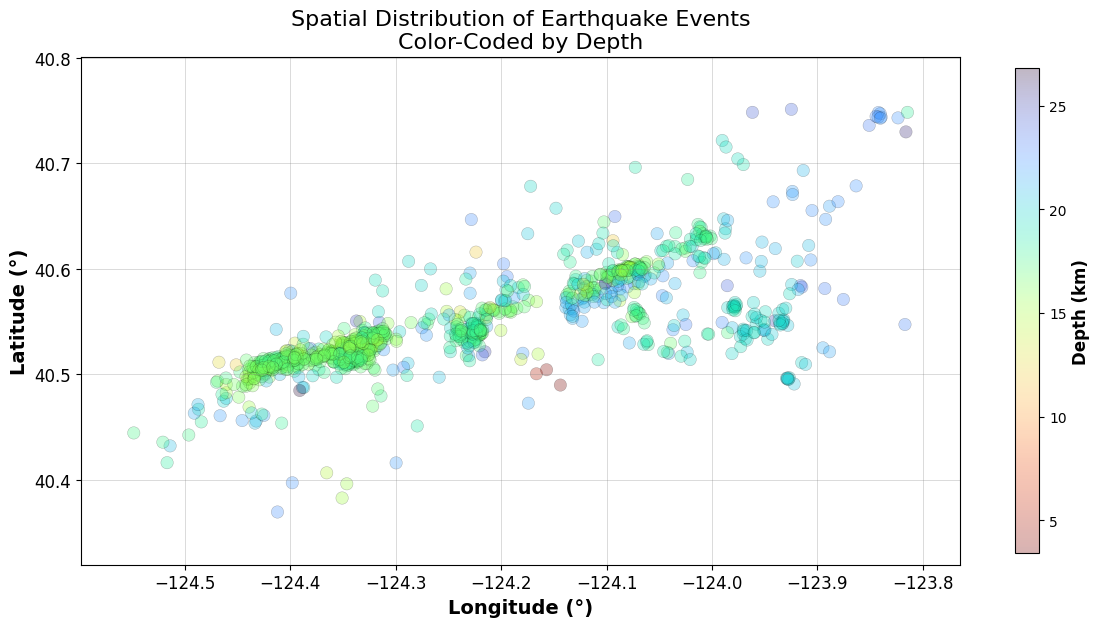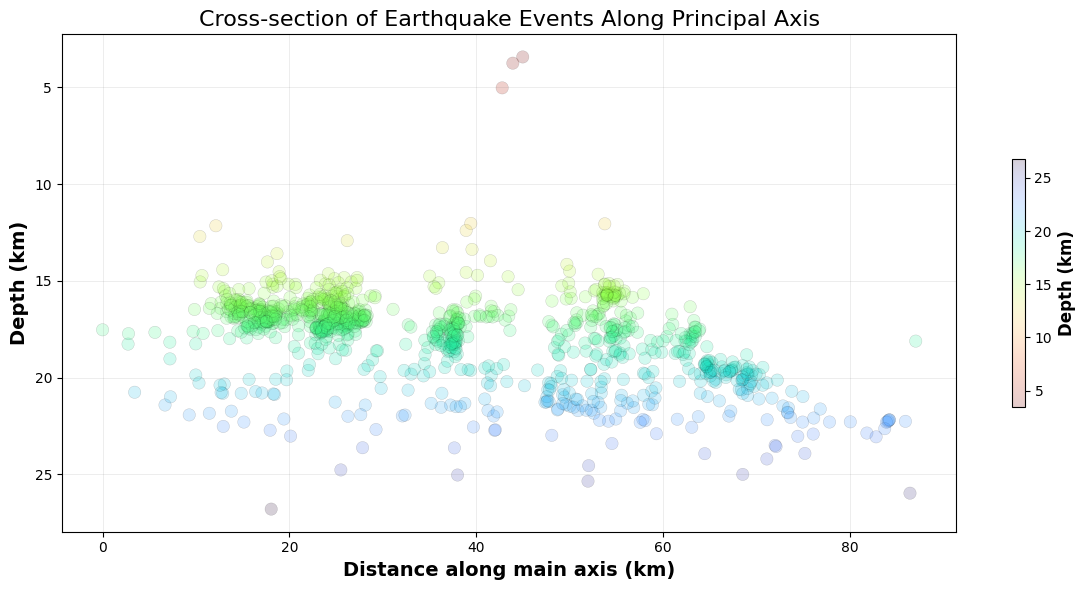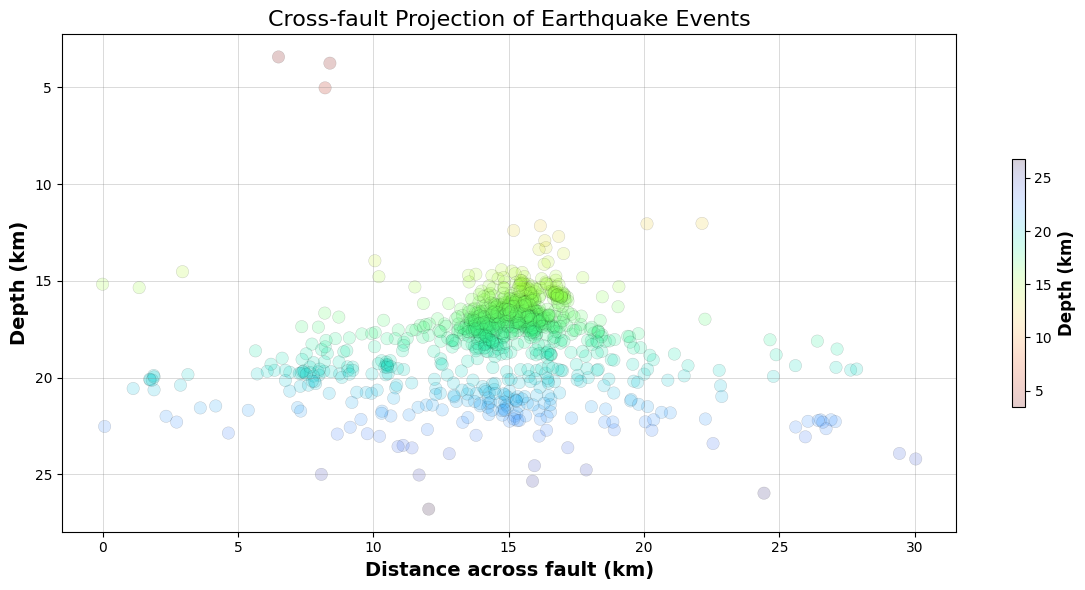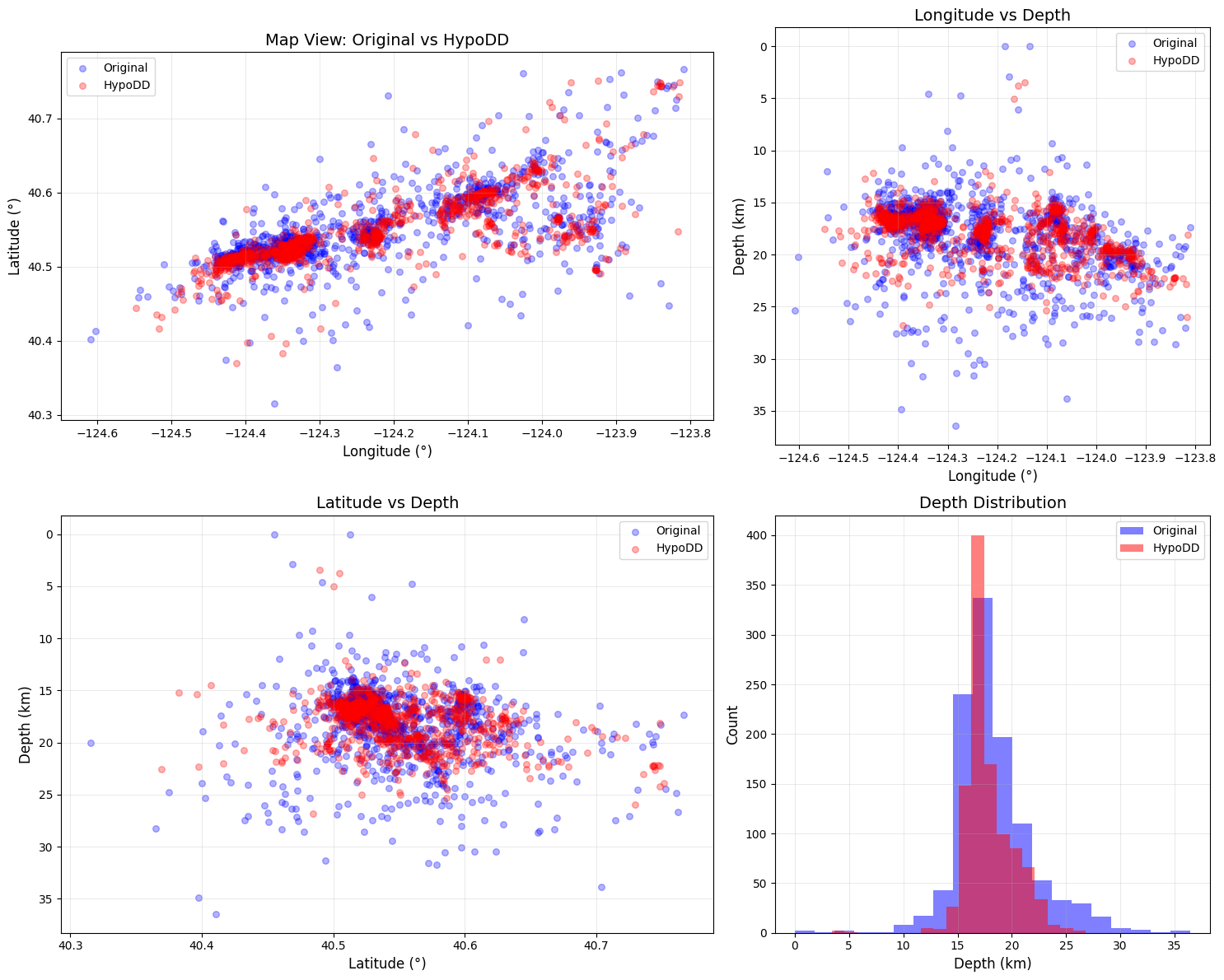Double Different Relocation#
This notebook will take the phase picks from the associated picks, perform double difference relocation, and plot the earthquake catalog.
by Felix Waldhauser
1. Compute differential times from phase file#
%cd /app/hypodd/results_hypodd
%pwd
!ph2dt ph2dt.inp
2. Run double-difference relocation#
!hypoDD hypoDD.inp
3. Manipulate the new catalog#
import pandas as pd
import matplotlib.pyplot as plt
import numpy as np
Read the relocated catalog
events_hypodd = pd.read_csv('./hypoDD.reloc',header=None, sep="\s+",names=['ID', 'LAT', 'LON', 'DEPTH', 'X', 'Y', 'Z', 'EX', 'EY', 'EZ', 'YR', 'MO', 'DY', 'HR', 'MI', 'SC', 'MAG', 'NCCP', 'NCCS', 'NCTP', 'NCTS', 'RCC', 'RCT', 'CID'])
events_hypodd
| ID | LAT | LON | DEPTH | X | Y | Z | EX | EY | EZ | ... | MI | SC | MAG | NCCP | NCCS | NCTP | NCTS | RCC | RCT | CID | |
|---|---|---|---|---|---|---|---|---|---|---|---|---|---|---|---|---|---|---|---|---|---|
| 0 | 10 | 40.479472 | -124.313924 | 17.746 | -7130.8 | -7587.8 | -504.3 | 495.2 | 464.1 | 446.2 | ... | 19 | 14.89 | 0.19 | 0 | 0 | 55 | 51 | -9.0 | 0.140 | 1 |
| 1 | 13 | 40.406616 | -124.365373 | 14.527 | -11497.3 | -15678.1 | -3723.3 | 690.2 | 1026.9 | 762.1 | ... | 29 | 21.75 | 0.73 | 0 | 0 | 12 | 4 | -9.0 | 0.150 | 1 |
| 2 | 14 | 40.514408 | -124.419613 | 15.401 | -16083.8 | -3708.3 | -2849.4 | 192.7 | 270.9 | 159.0 | ... | 34 | 24.66 | 6.09 | 0 | 0 | 654 | 711 | -9.0 | 0.211 | 1 |
| 3 | 15 | 40.588436 | -124.114697 | 17.217 | 9745.9 | 4512.1 | -1033.3 | 140.1 | 208.6 | 287.0 | ... | 35 | 59.17 | 3.73 | 0 | 0 | 604 | 798 | -9.0 | 0.168 | 1 |
| 4 | 16 | 40.517322 | -124.329557 | 17.127 | -8453.4 | -3384.8 | -1123.4 | 194.0 | 236.8 | 165.0 | ... | 36 | 14.62 | 3.13 | 0 | 0 | 156 | 443 | -9.0 | 0.109 | 1 |
| ... | ... | ... | ... | ... | ... | ... | ... | ... | ... | ... | ... | ... | ... | ... | ... | ... | ... | ... | ... | ... | ... |
| 1050 | 1157 | 40.539779 | -123.959904 | 19.063 | 22862.3 | -891.0 | 812.6 | 255.0 | 327.8 | 480.5 | ... | 54 | 8.52 | 0.57 | 0 | 0 | 446 | 560 | -9.0 | 0.167 | 1 |
| 1051 | 1158 | 40.576978 | -124.399479 | 22.143 | -14371.3 | 3239.7 | 3892.7 | 572.0 | 520.1 | 569.1 | ... | 55 | 52.26 | 0.75 | 0 | 0 | 11 | 9 | -9.0 | 0.188 | 1 |
| 1052 | 1159 | 40.531274 | -124.299154 | 15.873 | -5876.8 | -1835.4 | -2377.1 | 308.1 | 240.9 | 309.0 | ... | 56 | 37.56 | 0.74 | 0 | 0 | 232 | 293 | -9.0 | 0.175 | 1 |
| 1053 | 1160 | 40.633927 | -123.987695 | 19.623 | 20493.8 | 9563.7 | 1372.9 | 192.8 | 278.0 | 307.1 | ... | 58 | 40.20 | 1.13 | 0 | 0 | 370 | 412 | -9.0 | 0.179 | 1 |
| 1054 | 1161 | 40.628231 | -124.004533 | 17.401 | 19069.2 | 8931.2 | -849.6 | 186.2 | 260.1 | 280.6 | ... | 59 | 34.48 | 0.62 | 0 | 0 | 190 | 217 | -9.0 | 0.188 | 1 |
1055 rows × 24 columns
Plot
# Create a figure for the plot
fig = plt.figure(figsize=(12, 10))
ax = fig.add_subplot(111)
# Create scatter plot with depth-coded colors
scatter = ax.scatter(events_hypodd['LON'], events_hypodd['LAT'],
c=events_hypodd['DEPTH'],
cmap='turbo_r', # Use reversed turbo colormap (red for deep, blue for shallow)
s=80, # marker size for good visibility
marker='o',
edgecolor='k',
linewidth=0.3,
alpha=0.3)
# Add colorbar with depth information
cbar = plt.colorbar(scatter, ax=ax, shrink=0.5) # Adjust shrink to make the colorbar smaller
cbar.set_label('Depth (km)', fontsize=12, fontweight='bold')
cbar.ax.tick_params(labelsize=10)
# Set equal aspect ratio for proper geographical representation
ax.set_aspect('equal')
# Add grid with crisp styling
ax.grid(True, linestyle='-', linewidth=0.5, alpha=0.4, color='gray')
# Add descriptive labels
ax.set_xlabel('Longitude (°)', fontsize=14, fontweight='bold')
ax.set_ylabel('Latitude (°)', fontsize=14, fontweight='bold')
ax.set_title('Spatial Distribution of Earthquake Events\nColor-Coded by Depth', fontsize=16)
# Adjust limits with a small buffer around data points
buffer = 0.05
ax.set_xlim(events_hypodd['LON'].min() - buffer, events_hypodd['LON'].max() + buffer)
ax.set_ylim(events_hypodd['LAT'].min() - buffer, events_hypodd['LAT'].max() + buffer)
# Format tick labels
ax.tick_params(axis='both', which='major', labelsize=12)
plt.tight_layout()
plt.show()

Plot cross sections
Find the cross section along the main axis. Use PCA to find the long axis.
from sklearn.decomposition import PCA
import numpy as np
# Apply PCA to find the main axis of the earthquake cluster
# Extract coordinates for PCA
coords = events_hypodd[['LON', 'LAT']].values
pca = PCA(n_components=2)
pca.fit(coords)
# Project points onto the principal component
projected_points = pca.transform(coords)
# Convert projected points to actual distance in km using a crude approximation
# Scale factor: 1 degree ≈ 111.2 km
km_per_degree = 111.2
# Calculate the min and max in the projected space
min_proj = projected_points[:, 0].min()
max_proj = projected_points[:, 0].max()
# Calculate the total span in original coordinates
main_axis_vector = pca.components_[0] # Vector direction of main axis (LON, LAT)
# Calculate the span in degrees along the principal axis
span_degrees = np.sqrt((main_axis_vector[0]**2 + main_axis_vector[1]**2)) * (max_proj - min_proj)
# Convert to kilometers
span_km = span_degrees * km_per_degree
# Scale the projection to real distance in km
distance_km = (projected_points[:, 0] - min_proj) * span_km / (max_proj - min_proj)
# Create a new figure for the cross-section plot
fig, ax = plt.subplots(figsize=(12, 6))
# Plot depth vs distance along the main axis
sc = ax.scatter(distance_km, events_hypodd['DEPTH'],
c=events_hypodd['DEPTH'],
cmap='turbo_r',
s=80,
marker='o',
edgecolor='k',
linewidth=0.3,
alpha=0.2)
# Add colorbar with shrink parameter to make it smaller
cbar = plt.colorbar(sc, ax=ax, shrink=0.5)
cbar.set_label('Depth (km)', fontsize=12, fontweight='bold')
# Set labels and title
ax.set_xlabel('Distance along main axis (km)', fontsize=14, fontweight='bold')
ax.set_ylabel('Depth (km)', fontsize=14, fontweight='bold')
ax.set_title('Cross-section of Earthquake Events Along Principal Axis', fontsize=16)
# Add grid
ax.grid(True, linestyle='-', linewidth=0.5, alpha=0.2, color='gray')
# Adjust y-axis to show depth properly (negative values going down)
ax.invert_yaxis()
plt.tight_layout()
plt.show()
# Print direction of main axis for reference
main_axis_vector = pca.components_[0]
print(f"Main axis direction (LON, LAT): {main_axis_vector}")
print(f"Explained variance ratio: {pca.explained_variance_ratio_[0]:.2f}")
print(f"Total length of profile: {span_km:.2f} km")

Main axis direction (LON, LAT): [0.97499714 0.2222174 ]
Explained variance ratio: 0.97
Total length of profile: 87.06 km
from sklearn.decomposition import PCA
import numpy as np
# Apply PCA to find the main axis of the earthquake cluster
# Extract coordinates for PCA
coords = events_hypodd[['LON', 'LAT']].values
pca = PCA(n_components=2)
pca.fit(coords)
# Project points onto the principal component
projected_points = pca.transform(coords)
# Convert projected points to actual distance in km using a crude approximation
# Scale factor: 1 degree ≈ 111.2 km
km_per_degree = 111.2
# Calculate the min and max in the projected space for the second component (perpendicular to main axis)
min_proj2 = projected_points[:, 1].min()
max_proj2 = projected_points[:, 1].max()
# Calculate the total span in original coordinates
second_axis_vector = pca.components_[1] # Vector direction of second axis (LON, LAT)
# Calculate the span in degrees along the second principal axis
span_degrees2 = np.sqrt((second_axis_vector[0]**2 + second_axis_vector[1]**2)) * (max_proj2 - min_proj2)
# Convert to kilometers
span_km2 = span_degrees2 * km_per_degree
# Scale the projection to real distance in km
distance_km2 = (projected_points[:, 1] - min_proj2) * span_km2 / (max_proj2 - min_proj2)
# Create a new figure for the cross-section plot
fig, ax = plt.subplots(figsize=(12, 6))
# Plot depth vs distance across the main axis
sc = ax.scatter(distance_km2, events_hypodd['DEPTH'],
c=events_hypodd['DEPTH'],
cmap='turbo_r',
s=80,
marker='o',
edgecolor='k',
linewidth=0.3,
alpha=0.2)
# Add colorbar with shrink parameter to make it smaller
cbar = plt.colorbar(sc, ax=ax, shrink=0.5)
cbar.set_label('Depth (km)', fontsize=12, fontweight='bold')
# Set labels and title
ax.set_xlabel('Distance across fault (km)', fontsize=14, fontweight='bold')
ax.set_ylabel('Depth (km)', fontsize=14, fontweight='bold')
ax.set_title('Cross-fault Projection of Earthquake Events', fontsize=16)
# Add grid
ax.grid(True, linestyle='-', linewidth=0.5, alpha=0.4, color='gray')
# Adjust y-axis to show depth properly (negative values going down)
ax.invert_yaxis()
plt.tight_layout()
plt.show()
# Print direction of main axis for reference
main_axis_vector = pca.components_[0]
second_axis_vector = pca.components_[1]
print(f"Main axis direction (LON, LAT): {main_axis_vector}")
print(f"Second axis direction (LON, LAT): {second_axis_vector}")
print(f"Explained variance ratio: {pca.explained_variance_ratio_[0]:.2f}")
print(f"Width of cross-fault profile: {span_km2:.2f} km")

Main axis direction (LON, LAT): [0.97499714 0.2222174 ]
Second axis direction (LON, LAT): [-0.2222174 0.97499714]
Explained variance ratio: 0.97
Width of cross-fault profile: 30.03 km
Now we are going to compare before and after relocation.
# Read the original catalog for comparison
events_original = pd.read_csv('./HypoDD.loc', header=None, sep="\s+",
names=['ID', 'LAT', 'LON', 'DEPTH', 'X', 'Y', 'Z', 'EX', 'EY', 'EZ',
'YR', 'MO', 'DY', 'HR', 'MI', 'SC', 'MAG', 'NCCP', 'NCCS', 'NCTP',
'NCTS', 'RCC', 'RCT', 'CID'])
# Create a figure with 2x2 grid for comparing before and after
fig = plt.figure(figsize=(15, 12))
gs = fig.add_gridspec(2, 2, width_ratios=[1.5, 1])
# Map view comparison (top-left)
ax1 = fig.add_subplot(gs[0, 0])
ax1.scatter(events_original['LON'], events_original['LAT'], c='blue', s=30, alpha=0.3, label='Original')
ax1.scatter(events_hypodd['LON'], events_hypodd['LAT'], c='red', s=30, alpha=0.3, label='HypoDD')
ax1.set_xlabel('Longitude (°)', fontsize=12)
ax1.set_ylabel('Latitude (°)', fontsize=12)
ax1.set_title('Map View: Original vs HypoDD', fontsize=14)
ax1.legend()
ax1.grid(True, linestyle='-', linewidth=0.5, alpha=0.4)
ax1.set_aspect('equal')
# Depth cross-section along longitude (top-right)
ax2 = fig.add_subplot(gs[0, 1])
ax2.scatter(events_original['LON'], events_original['DEPTH'], c='blue', s=30, alpha=0.3, label='Original')
ax2.scatter(events_hypodd['LON'], events_hypodd['DEPTH'], c='red', s=30, alpha=0.3, label='HypoDD')
ax2.set_xlabel('Longitude (°)', fontsize=12)
ax2.set_ylabel('Depth (km)', fontsize=12)
ax2.set_title('Longitude vs Depth', fontsize=14)
ax2.legend()
ax2.grid(True, linestyle='-', linewidth=0.5, alpha=0.4)
ax2.invert_yaxis() # Depths increase downward
# Depth cross-section along latitude (bottom-left)
ax3 = fig.add_subplot(gs[1, 0])
ax3.scatter(events_original['LAT'], events_original['DEPTH'], c='blue', s=30, alpha=0.3, label='Original')
ax3.scatter(events_hypodd['LAT'], events_hypodd['DEPTH'], c='red', s=30, alpha=0.3, label='HypoDD')
ax3.set_xlabel('Latitude (°)', fontsize=12)
ax3.set_ylabel('Depth (km)', fontsize=12)
ax3.set_title('Latitude vs Depth', fontsize=14)
ax3.legend()
ax3.grid(True, linestyle='-', linewidth=0.5, alpha=0.4)
ax3.invert_yaxis() # Depths increase downward
# Depth histogram comparison (bottom-right)
ax4 = fig.add_subplot(gs[1, 1])
ax4.hist(events_original['DEPTH'], bins=20, alpha=0.5, color='blue', label='Original')
ax4.hist(events_hypodd['DEPTH'], bins=20, alpha=0.5, color='red', label='HypoDD')
ax4.set_xlabel('Depth (km)', fontsize=12)
ax4.set_ylabel('Count', fontsize=12)
ax4.set_title('Depth Distribution', fontsize=14)
ax4.legend()
ax4.grid(True, linestyle='-', linewidth=0.5, alpha=0.4)
plt.tight_layout()
plt.show()
# Calculate and print some statistics about the differences
print(f"Mean location changes:")
print(f" Latitude: {(events_hypodd['LAT'] - events_original['LAT']).mean():.6f} degrees")
print(f" Longitude: {(events_hypodd['LON'] - events_original['LON']).mean():.6f} degrees")
print(f" Depth: {(events_hypodd['DEPTH'] - events_original['DEPTH']).mean():.2f} km")
print(f"Maximum location changes:")
print(f" Latitude: {(events_hypodd['LAT'] - events_original['LAT']).abs().max():.6f} degrees")
print(f" Longitude: {(events_hypodd['LON'] - events_original['LON']).abs().max():.6f} degrees")
print(f" Depth: {(events_hypodd['DEPTH'] - events_original['DEPTH']).abs().max():.2f} km")

Mean location changes:
Latitude: -0.001978 degrees
Longitude: -0.001164 degrees
Depth: -0.39 km
Maximum location changes:
Latitude: 0.300660 degrees
Longitude: 0.726135 degrees
Depth: 19.54 km
